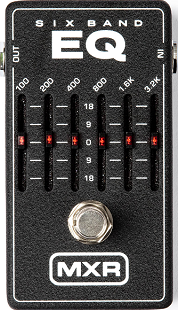Difference between revisions of "M109 6-band EQ"
(→Schematic) |
|||
| Line 43: | Line 43: | ||
==Schematic== | ==Schematic== | ||
| − | We do not have a schematic for the MXR 6-band EQ, however, we found a very good schematic for the MXR [[ | + | We do not have a schematic for the MXR 6-band EQ, however, we found a very good schematic for the MXR [[M108 10-Band EQ]], and when combined with the information from the Geofex website (linked below) should give everyone enough information to understand the simpler 6-band EQ. |
==Artists== | ==Artists== | ||
Revision as of 15:29, 17 April 2019
MXR M109 6-band EQ. This pedal is the "smaller brother" to the M108 10-band EQ, having exactly half the faders that the M108 does. This does not mean that the M109 is not a worthwhile pedal. While we have affection for the M108, the M109 is almost as useful, as it covers a span of the most useful frequencies. It's small and therefore doesn't represent a high burden with respect to pedalboard real estate.
Renting this pedal is actually a pretty good means of determining for yourself if you need the 10-band, or if just the 6-band EQ will work for you without having to make the larger commitment of an outlay of money for both to determine which works best for you.
- Thermionic Studios has one (1) M109 6-Band EQ available for rental
Controls

- Fader 1 - "100Hz": 100 Hertz. "Bass" frequency
- Fader 2 - "200Hz": 200 Hertz.
- Fader 3 - "400Hz": 400 Hertz.
- Fader 4 - "800Hz": 800 Hertz. This is just below where audio engineers and audiophiles describe "midrange" frequencies existing.
- Fader 5 - "1.6KHz": 1,600 Hertz.
- Fader 6 - "3.2KHz": 3,200 Hertz - upper midrange to treble frequency.
- Footswitch 1 - "On/Off": This switch toggles between active or engaged ("On") and bypassed ("Off").
Note that in the middle of the pedal MXR has labelled the enclosure with a painted indicator showing +18 dB to -18dB in the span of the faders.
Setting the fader for a particular frequency at "0" (zero) means that that frequency is being neither boosted nor attenuated. An M109 with all faders at "0" should have the same volume level and therefore sound the same when "on" as "off. This is called "Unity Gain". Moving the fader of a selected frequency up increases the volume of that frequency in the output signal; likewise, sliding that same fader below "0" reduces the volume of that same frequency.
Note that while the M108 10-Band EQ offers separate Volume and Gain faders on each side of that pedal, the M109 6-Band does not. However, MXR tries to make up for it by offering +. If many or most of the frequency faders are at zero or below, the total signal level coming out of the pedal may be below the original unity volume level.
Bypass: "Hardwire"
Just as in the case with the 10-band EQ, the M109 uses what Dunlop calls "Hardwire Bypass". This doesn't mean that the bypass is buffered, but it does mean that this pedal can weigh down your signal because the effect is not fully bypassed by MXR's switching mechanism.
General Information
High Jack Placement
The M109 6-band is a small pedal. As a result, it's crammed with electronic components. However, MXR's decision to go this route forced the 1/4" instrument jacks to be located much closer to the "top" face of the pedal. This placement is uncommon for a pedal of this size. Take a look at the picture of this pedal and you'll see that the jacks are very close to the top face and are even labeled as such on the front face of the pedal. (See "In" and "Out" accordingly.)
We point this out merely to make you aware of the possibility of having to partake in some pedalboard contortions: setting up patch cables in a manner you might not at first be prepared for. It shouldn't be a big deal, but people can be, and are, rather particular about their pedalboards.
Pedal Manual
Phase Inversion: Tentative "No"
Given that we do not have a schematic for the M109 6-band EQ, we cannot state authoritatively that this pedal inverts phase, however, when we look at the schematic for the M108 10-band, it's clear that it uses the opamps in a non-phase inverting manner. There is no reason for MXR to break with that precedent for a smaller pedal, and the extra work it would entail to make the pedal invert phase.
Schematic
We do not have a schematic for the MXR 6-band EQ, however, we found a very good schematic for the MXR M108 10-Band EQ, and when combined with the information from the Geofex website (linked below) should give everyone enough information to understand the simpler 6-band EQ.
Artists
We are currently unaware of any artists actively using the pedal now, or who have in the past.
- Additional Sources